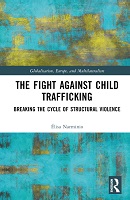Chapter 3 The apparatus of child protection
Proposal review
“Letting die” the trafficking victims
| dc.contributor.author | Narminio, Elisa | |
| dc.date.accessioned | 2023-03-09T09:49:05Z | |
| dc.date.available | 2023-03-09T09:49:05Z | |
| dc.date.issued | 2023 | |
| dc.identifier.uri | https://library.oapen.org/handle/20.500.12657/61665 | |
| dc.description.abstract | The purpose of the present chapter is to initiate the analysis of the child trafficking apparatus through the examination of a paradox pertaining to the protection of children: the simultaneous acceptance of a universal norm of child protection, and the frequent vulnerabilisation of trafficked children who have been taken into care. This discrepancy raises a set of interrogations about the politics of “making live” or “letting die” (Foucault), and the clashes that shape the manner in which the issue is settled for identified trafficking victims. Drawing on Foucaultian analyses of biopower, Chapter 3 shows the internal tension between “make live” objectives and “let die” practices unfolding in the global protection apparatus and its manifestations in member states of ASEAN and the EU. Through a set of solid data collected through fieldwork and interviews, it argues that the protection apparatus deviates towards unintended consequences or biopolitics of selection, resulting in non-protection mechanisms for children identified as trafficking victims. The biopolitics of the child protection apparatus, where trafficking victims are concerned, is analysed along the lines of their politics of selection; the material, psychological and symbolic liminal spaces it produces; and the fabrics – that is, the mechanisms –, as well as the fabric –namely the intrinsic structure of the protection apparatus – that amplify the initial vulnerability of children. | en_US |
| dc.language | English | en_US |
| dc.subject.classification | thema EDItEUR::J Society and Social Sciences::JP Politics and government | en_US |
| dc.subject.classification | thema EDItEUR::J Society and Social Sciences::JP Politics and government::JPV Political control and freedoms::JPVH Human rights, civil rights | en_US |
| dc.subject.classification | thema EDItEUR::L Law::LN Laws of specific jurisdictions and specific areas of law::LNM Family law::LNMK Family law: children | en_US |
| dc.subject.classification | thema EDItEUR::L Law::LB International law | en_US |
| dc.subject.other | child trafficking; human trafficking; trafficking; anti-trafficking policies; EU-ASEAN; ASEAN; Human Rights; governance | en_US |
| dc.title | Chapter 3 The apparatus of child protection | en_US |
| dc.title.alternative | “Letting die” the trafficking victims | en_US |
| dc.type | chapter | |
| oapen.identifier.doi | 10.4324/9781003309031-6 | en_US |
| oapen.relation.isPublishedBy | 7b3c7b10-5b1e-40b3-860e-c6dd5197f0bb | en_US |
| oapen.relation.isPartOfBook | 7fdad6bc-f425-4bae-aad9-9383c33df47e | en_US |
| oapen.relation.isFundedBy | 11a48a98-94db-40cf-a3ea-f784d9d56eee | en_US |
| oapen.relation.isbn | 9781032312804 | en_US |
| oapen.relation.isbn | 9781032312934 | en_US |
| oapen.imprint | Routledge | en_US |
| oapen.pages | 41 | en_US |
| oapen.remark.public | Funder name: IEE - Université Libre de Bruxelles | |
| peerreview.anonymity | Single-anonymised | |
| peerreview.id | bc80075c-96cc-4740-a9f3-a234bc2598f1 | |
| peerreview.open.review | No | |
| peerreview.publish.responsibility | Publisher | |
| peerreview.review.stage | Pre-publication | |
| peerreview.review.type | Proposal | |
| peerreview.reviewer.type | Internal editor | |
| peerreview.reviewer.type | External peer reviewer | |
| peerreview.title | Proposal review | |
| oapen.review.comments | Taylor & Francis open access titles are reviewed as a minimum at proposal stage by at least two external peer reviewers and an internal editor (additional reviews may be sought and additional content reviewed as required). |

